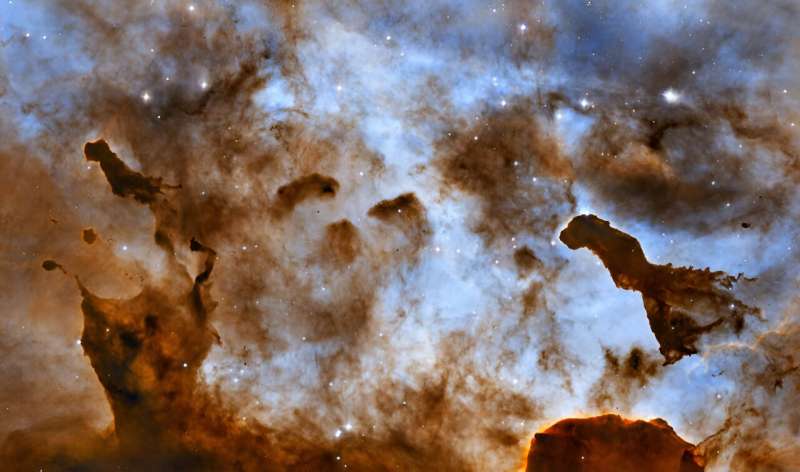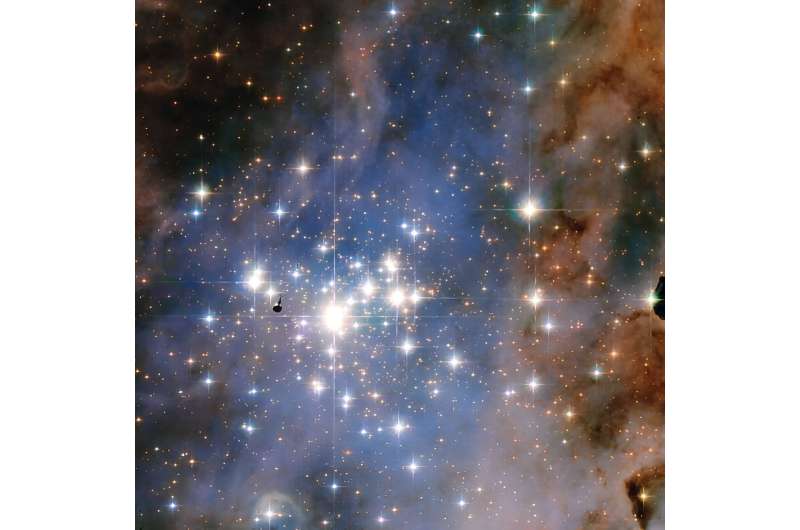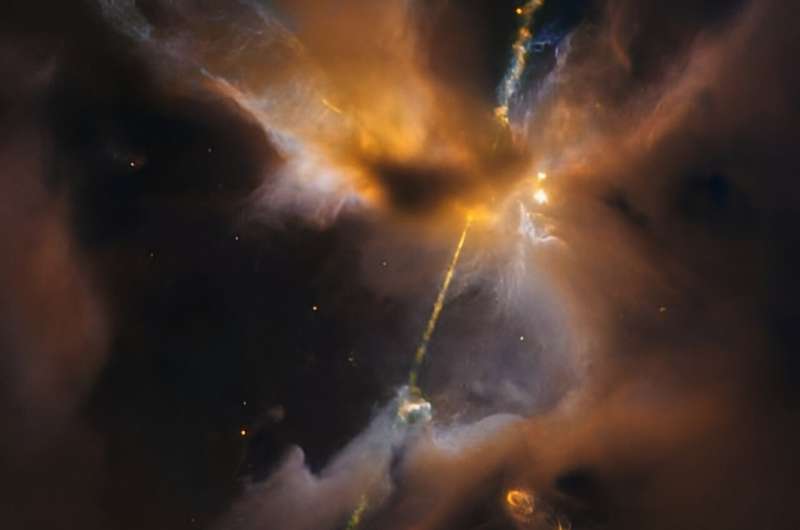This article has been reviewed according to Science X's editorial process and policies. Editors have highlighted the following attributes while ensuring the content's credibility:
fact-checked
preprint
trusted source
proofread
What's inside the Carina pillars? Massive protostars and newly forming planets

Star-forming nebulae are busy places. Unfortunately, clouds of gas and dust usually hide the action. To cut through the dust in one such region, a team of astronomers used the Atacama Large Millimeter Array (ALMA). They peered inside the Pillars of the Carina Nebula and studied molecular outflows (or jets) emanating from objects in this famous star-birth nursery.
Ph.D. student Geovanni Cortes-Rangel of the Instituto de Radioastronomía y Astrophysíca in Mexico, along with other team members from Mexico and Japan, wanted to know more about the action inside those pillars. There's a lot going on in those pillars and in the nebula surrounding them. For one thing, a pair of massive star clusters dominates the region. Trumpler 14 and Trumpler 16 contain dozens of hot young O-type stars that are emitting huge amounts of ionizing ultraviolet radiation.
That radiation bathes nearby regions of the nebula and illuminates and sculpts the dusty pillars. That, in turn, helps reveal the presence of protostars, their protoplanetary disks, and jets. Between the star-birth activity and photodissociation of the cloud due to the UV radiation, this is definitely an extreme environment. But, thanks to that radiation, astronomers are able to zero in on the newborn stars and disks to understand what's happening behind the dusty veil.
Tracking bright sources in the pillars
The result of the team's studies reveals the masses of the circumstellar disks around the newly forming stars. They've also been able to measure the extent of related molecular outflows, or jets. The team concluded that the sources of those jets are low- or intermediate-mass protostars. As infant stars form, infalling material gets heated and ejected in a bipolar flow along the spin axis of the protostar. The jets eventually plow into the gas and dust of the star-birth crèche. The collisions excite gases in the nebulae and cause them to light up. These jets move very fast, up to hundreds of thousands of kilometers per hour.

Astronomers refer to the excited clouds of gas and dust associated with the protostars as Herbig-Haro Objects. Those are bright nebulosities inside larger nebulae that exist thanks to those newborn stars. They're named for George Herbig and Guillermo Haro, who first studied them in great detail. Essentially, they're part of the star-birth process.
The baby stars in the Carina pillars showed up in other infrared and submillimeter measurements of the area. In some cases, multiple suspected protostars are associated with additional jet activity. All in all, this star-birth region appears to be a busy place, bristling with newborn stars hidden in the clouds of gas and dust. Cortes-Rangel and his associates studied six Carina pillars in detail, looking at sources associated with the embedded Herbig-Haro Objects. Their results have been posted to the arXiv preprint server.
Understanding Herbig-Haro objects in Carina
In the ALMA data, the team found several compact sources giving off millimeter-wavelength radiation. They are the Herbig-Haro objects HH 666, HH 1004, HH 1006, HH 1010, and HH 1066. They also detected carbon monoxide outflows associated with the objects. The action from these HH objects is pretty intense. For example, HH 666's jets stretch out across at least 10 light-years from the source. The jets themselves appear twisted and create large bow shocks where they slam into the surrounding nebula.
HH 666 is probably the best-known of these objects. It's fairly well-known and has been observed in visible and infrared light, as well as at millimeter wavelengths. It contains a protostar that is likely the source of the extensive optical jet. Hubble Space Telescope observations, using Advanced Camera for Surveys, revealed the extent of the jet and showed what's hidden inside its home pillar.

Why study outflows in the pillars?
The idea behind this set of observations (which builds on previous work by Cortes-Rangel and others) is to understand the complex activities inside the pillars. That's why the team set out to use ALMA to reveal the HH objects, their "exciting sources" (i.e., jets), and their circumstellar disks. The data gave them an inside peek at the physical conditions inside the pillars and let them see how the harsh radiation environment affects the evolution of the baby stars and their possible planet nurseries.
The outflows from the infant stars themselves are carving out voids in the pillars. From this and other observations, the team estimates that this photoevaporation action could destroy the pillars in as little as 100,000 to a million years. Once the pillars are gone, the circumstellar disks around newly forming stars inside would be exposed to radiation from the Trumpler clusters. They'd most likely be transformed into protoplanetary disks (like those seen in Orion) in fairly short order as the radiation sculpts them.
What about planetary formation?
Since planets form inside circumstellar disks and protoplanetary disks around stars, another question comes up: how would this environment affect planet formation? Cortes-Rangel's team also looked at possibilities for planet formation inside these targeted star-birth nurseries.
They found that planetary formation might be possible in the environment of the pillars. That's because, even taking into account the photoevaporation of disks around newly forming stars, enough dust mass might be left to form planets. They calculated values between 0.01 and 0.7 solar masses of material left over. That's just enough material and the team suggests that it's possible planets have either formed in the region or are actively forming. Future observations might be able to find more evidence for those infant worlds.
These measurements provide a guide to studying other busy star-birth regions in the galaxy using millimeter wavelength measurements. ALMA is perfectly placed to "cut through" the clouds of gas and dust that accompany star birth. As this study shows, it also lets astronomers put more constraints on the physical conditions that accompany the creation of new stars and planets.
More information: Geovanni Cortes-Rangel et al, ALMA Observations of the Extraordinary Carina Pillars: A Complementary Sample, arXiv (2023). DOI: 10.48550/arxiv.2310.10801
Journal information: arXiv
Provided by Universe Today





















